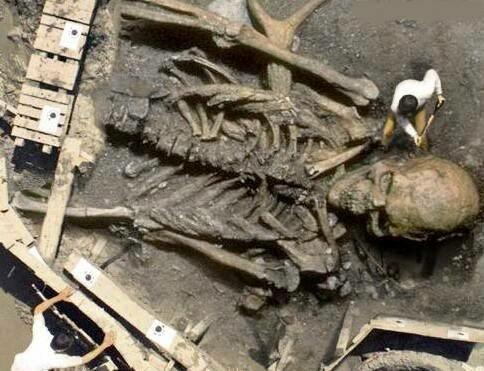Richard Beck is teaching through the book of Genesis and, like most readers, trips over the very weird bit at the beginning of chapter 6 on “the Nephilim.”

I’ve never figured out what to make of that, or how this odd fragment from the Silmarillion wound up in the Hebrew scriptures. But it is one of the big flashing signals that these early chapters of Genesis do not invite or allow a “literal” reading in the style of modern-day American fundies.
I don’t just mean because giants and talk of “heroes of old” are huge screaming clues that this is a bit of legendary narrative. There’s also the problem that this bit defies the anachronistic journalistic reading that is referred to as “literalism.” Consider that these inexplicable “Nephilim” show up again later, in Numbers 13, when the Hebrew spies returning from Canaan say, “We saw Nephilim there” and the text says, parenthetically, “the descendants of Anak come from the Nephilim.”
A creationist-style “literal” reading says that’s impossible — the Nephilim all died in Noah’s flood. (Somewhere, I’m sure, some “scientific creationist” crypto-archaeologist — Ron Wyatt, perhaps — is collecting money for an expedition to search for Nephilim fossils.)
If you want to take a trip through the looking glass, Google around to read some of the more imaginative things written by those who insist that this story is a “literal,” historical account. It’s entertaining, and somehow appropriate, to see folks like Ken Ham and Henry M. Morris cited alongside Erich von Daniken and Zecharia Sitchin.
So what does this weird little passage mean? I have no idea. Beck guesses that “this strange text” expresses some early “concern over illicit mixing” — going on to note that such concern is something later prophets, Jesus and Paul took pains to condemn.
Beck is teaching through Genesis at a prison Bible study. The next book is Exodus. The idea of studying Exodus in a prison reminds me of that scene from Shawshank where they’re sorting books for the prison library and come across The Count of Monte Cristo:
ANDY: You know what it’s about? You’ll like it, it’s about a prison break.
RED: We oughta file that under “Educational” too, oughten we?
* * * * * * * * *
In another discussion of the early chapters of Genesis, Scot McKnight writes: “I heard Tom Wright say election is at work in God choosing Adam and Eve from others to be the ones with the image of God.”
Wright seems to have his chapters mixed up. The bit about the “image of God” is not part of the story of Adam and Eve, it’s from the previous story and applies to all of humanity — to adam but not to “Adam.”
“God choosing Adam and Eve from others to be the ones with the image of God” is something that never happens in the Bible. That’s the opposite of what happens in the Bible. The first story says that all of humanity is made in the image of God, and we can apply that to the second story to infer that, because Adam and Eve are humans, that is also true of them. But these two stories cannot be made to say that Adam and Eve bear the image never attributed to them in their story while “others” do not bear the image attributed to them in theirs.
Any attempt to explain why “God [chose] Adam and Eve from others to be the ones with the image of God” is bound to be as helpful and insightful as trying to explain why God chose Adam and Eve to build an ark, or why God chose Adam and Eve to face Goliath armed only with a sling. Wrong story.
* * * * * * * * *
At Internet Monk, Chaplain Mike looks at the three main different ways of numbering the Ten Commandments. He picks a favorite, preferring the Talmudic approach of regarding the Decalog as the “Ten Words.”
That’s a different numbering than the one used by Lutherans and Roman Catholics, and it’s also different from the numbering preferred by most Protestants, Greek Orthodox and some Jews.
The fact that different branches of Christianity and Judaism number these commandments differently isn’t a big deal. The text itself doesn’t number them, and regardless of how they’re numbered, the content of the Ten Commandments doesn’t change. How you prefer to number them only matters if, say, you wanted to make a plaque or a monument with the commandments engraved on it.
Uh-oh …
This point is largely ignored by those who imagine they can put such a plaque or monument in a public building without establishing anything more than a vaguely non-sectarian “Judeo-Christian” form of ceremonial civil religion.
Nope. If you want to hang the Ten Commandments in a courtroom, you’re going to have to pick sides — privileging one Christian sect over another. Before you commission such a plaque or monument you first have to decide if it’s going to hang in a Lutheran courtroom or in a Methodist courtroom.
Does the First Amendment allow for such a thing as a sectarian courtroom? No, it really does not.












